In Greek, there is the word "scolios", which results in "twisted".With this word, doctors designate the curvature of the spine.In addition, any curvature, namely the lateral deviation of the vertical axis of the spine.The fact is that normally our spine is not perfectly uniform.The turns available at the front and at the rear (lordship and kyphosis) protect our spine against excessive loads while maintaining the body in a certain position during movement and weight.The negative processes in our body only develop in cases where these kyphoses and lordos are expressed in addition to the authorized standard.
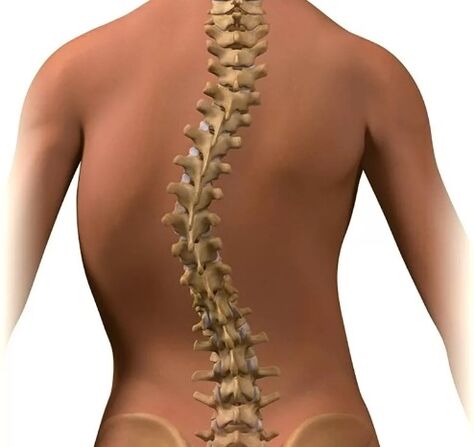
The main problems
However, even a small degree of lateral turns (scoliosis) of the spine is always a pathology.And the point is not only in a cosmetic defect.Although a characteristic repulsive appearance with pronounced or progressive scoliosis is always a tragedy for a person who seeks to live a high quality life.This is particularly true for young boys and girls.Indeed, it is in the period of children and young people (up to 15 to 16 years) that a significant part of scoliosis is diagnosed.
The main problem is that because of a change in configuration and volume of the chest with a pronounced lateral curvature, the internal organs always suffer (heart, lungs, stomach, liver, intestines, large vessels).In men, tolerance to physical exertion decreases, women have problems of design, pregnancy and procreation.In addition, very often, the lateral deformation of the spine is only the part of the iceberg, which is a sign of a much more serious pathology - tumor, tuberculosis, endocrine disorders.
Reasons
So why is the spine deformed?Before answering the question, you must decide the types of scoliosis.Basically, scoliosis can be structural and not structural.Structural scoliosis develops due to anatomical changes in the structure of the bone tissue of the vertebrae, as well as muscles, nerves and ligament devices located nearby.These curvatures can be acquired and congenital, and approximately a quarter of all diagnosed scoliosis represent the latter.
Among the main reasons for the development of structural scoliosis, they distinguish:
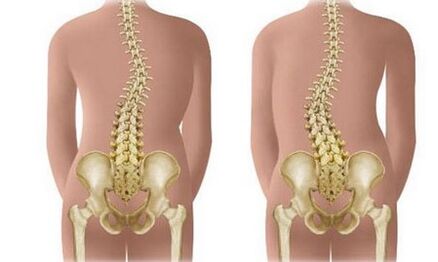
- Intrauterine development masts leading to dysplastic disorders from one or more vertebrae
- Congenital anomalies in chest development - Lack of ribs, additional ribs
- Congenital pathology of connective tissue - Neurofibromatosis, Marfan syndrome
- Brain failure due to children's cerebral paralysis (cerebral paralysis), resulting in violation of the innervation of certain parts of the spine
- Osteoporosis (bone tissue) of the spine in rissing, diseases of the parathyroid glands, lack of calcium consumption with food
- Osteomyelitis of the vertebrae
- Dystrophic changes in cervical, thoracic and lumbar muscles
- Tuberculosis Damage to the vertebrae
- Spine injuries
- Tumors of the spine.
Non -structural scoliosis, as follows from the very name, is the lateral differences in the axis of the spine with the unchanged structure of the vertebrae.As a general rule, such scoliosis is most often acquired with the exception of cases where curvature is compensatory in nature with congenital anatomical defects in the basin or lower limbs.The causes of such scoliosis are most often:
- Pelvic injuries and lower limbs
- Congenital defects in the basin and the lower limbs
- Constant inappropriate posture in schoolchildren
- Internal organ diseases with pain syndrome expressed asymmetrically
- Muscle inflammation (myosites)
- Burns, mus fabric scars on one side.
In these cases, to eliminate the curvature of the spine, it is enough to cure the underlying disease, and therefore many non-structural scoliosis are easily reversible.In this regard, some doctors tend to not count unstructural deformations for scoliosis in general.
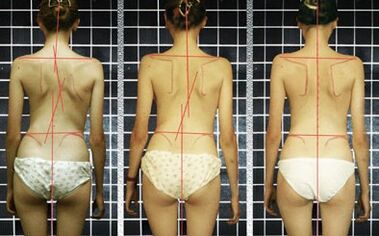
Recently, cases of development of scoliosis with unclear causes have become more frequent.This is idiopathic scoliosis if called.It occurs in the years of youth, during the period of rapid growth of the body.In addition, girls suffer from idiopathic scoliosis several times more often than young men.Apparently, this is due to the relatively low muscles of the rear of the female, who is unable to lock the spine in a complete muscle frame.An unbalanced diet with low calcium salts and a general passion for young people with carbonated drinks do not play a final role in the development of idiopathic scoliosis.As you know, carbon dioxide in bubbles and speech therapy acid in synthetic inclusions contributes to the leachate of calcium salts of the body.
Varieties and diplomas
Depending on the location, scoliosis can be cervical, thoracic, lumbar or mixed (cervical, lombo-sacred).It is possible to have one or more arches of curvature.In this regard, scoliosis in the shape of C (with 1 arc), in the shape of S (with 2 arcs) and in the shape of Z (with 3 arcs) are distinguished.Most likely, the presence of 2 or 3 arcs is compensatory.With C -shaped scoliosis, the axis of the spine departs.In an effort to compensate for this, the spine folds in the opposite direction.In this regard, scoliosis is divided into offset and not offset.In a compensated vertebral curvature, a vertical line lowered from the 7th cervical vertebra passes through the fold between the buttocks.
The curvature of the spine is often combined.For example, in the chest region, in addition to the lateral curvature, a pathological cyphosis is noted or simply a bump.In these cases, speaking of thoracic kyphoscoliosis.In addition, with great degrees of scoliosis, in addition to the lateral movement of the vertebrae, Thuria is noted.In a literal translation, it means a twist.Indeed, with many scoliosis, the vertebral bone tissue is twisted along the vertical axis.
Depending on the size of the angle of the curvature arc, 4 degrees of scoliosis are distinguished:
- 1 degree- The angle of curvature does not exceed 10 degrees.Asymmetry to the eye is practically not determined.The pole, the unequal level of the shoulder belt, be careful.
- 2 degrees- The curvature angle is 11 to 25 degrees.In this extent, the vertebrae are already noted.There is an asymmetry of the shoulder belt and the pelvis which is visible on the eye.Due to pathological muscle tension, a muscle roller is formed in the lumbar region on the concave side and in the chest with a convex.
- 3 degrees- Wrtification is 26 to 50 degrees.Visible deformation of the chest - the west of intercostal spaces C in the concave side of the curvature and the bulge with Convex.Weakening the abdominal press, formation of an internal bump.
- 4 degrees- The angle of curvature I exceeds 50 degrees.A cosmetic defect and all the previous signs are expressed.Low tolerability of a even small physical effort.In addition to the musculoskeletal system, the internal organs suffer.
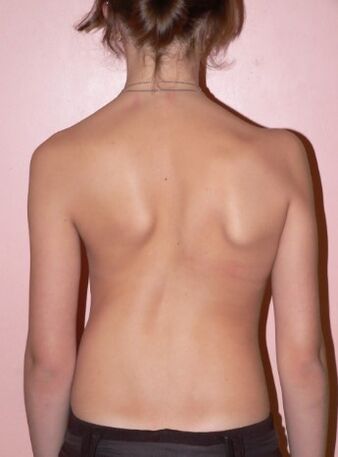
The angle can vary depending on the position of the body, while stable and unstable scoliosis is distinguished.With unstable scoliosis, it decreases in a lie when the load on the spine decreases.With a stable curvature of the spine, this value remains unchanged.
Symptoms
Recently, orthopedists often use the term "scoliotic disease".And they indicate a complex of negative changes that occur in the body during the curvature of the spine.As a rule, scoliotic diseases are developing in childhood and adolescence, during the formation of the musculoskeletal system.Currently, there is a high probability that scoliosis is progressing.
Apparently, intervertebral discs play an important role in increasing the angle of curvature.With lateral displacement, the disc undergoes uneven pressure from the vertebral bodies.On the concave side, this pressure is greater, with a convex - less.Consequently, the disc use even more of scoliosis, a pathological muscle tension (muscle roller) and a torsion of the vertebrae are created - all this leads to the appearance of discs and a new increase in the angle of curvature.
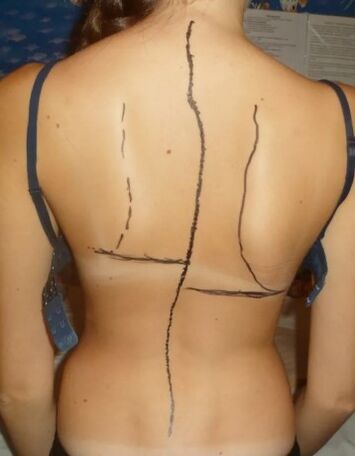
In addition to the spine with scoliotic disease, the chest changes secondly.The bump of ribs thus called is formed - on the convex side of the curvature, the intercostal spaces expand and the concave - on the contrary, they are sown.With 4th degree scoliosis, the deformation of the chest is so pronounced that the lower ribs on the side of the curvature are in contact with the iliac bone rowing.
Due to a severe deformation of the chest, an excursion in its own right during breathing is difficult.Consequently, the organism suffering from severe scoliosis does not receive the required quantity of oxygen - Chronic Hypoxy So Called develops with a violation of all the metabolic processes of the body.The pathology is aggravated by the fact that the internal volume and the form of the change of chest of thoracic cavities.For this reason, the blood circulation through the vessels is disturbed, the lungs suffer, the shape of heart changes, chronic cardiovascular failure is developing.
Similar changes occur in the abdominal organs for lumbar and lumbosacre scoliosis.The motorcycles of the stomach and intestines are reduced with a subsequent enzymatic insufficiency of the digestive glands.All this aggravates only metabolic disorders.These violations often lead to late sexual maturation of boys and girls.In addition, due to lumbar scoliosis, the basin is curved a second time.This creates problems for future mothers with gestation and procreation.
Diagnosis
The diagnosis of scoliosis, in particular great degrees, as a rule, is not difficult.To detect the deformation of the spine, a common visual examination is often sufficient.The visible curvature of the contours of the spine, the asymmetry of the shoulder belt, the angles of the shoulder blades, the secondary curvature of the basin and the shortening of the lower limb on the side of the curvature are notable.
In the presence of at least one of these signs, an x -ray of the spine is indicated.The X -ray determines the configuration, the degree and the location of the curvature.During the inspection and radiological examination, it is possible to determine whether scoliosis is offset and stable.Recently, a qualitatively new method of research on magnetic resonance imaging (MRI) was spread, during which a three -dimensional image of the spine can be obtained on the monitor screen.With significant curvatures, it is necessary to study the work of internal organs - to carry out spirometry, electrocardiography and perform an ultrasound of the heart and internal organs.
Treatment
The treatment of scoliosis can be carried out both in a conservative and rapid manner.Conservative methods include drug treatment, massage, physiotherapeutic procedures and manual therapy.It should be kept in mind that the final training of the spine ends at the age of 20, and after this age, the curvature correction is almost impossible.With scoliosis of 1 to 2 degrees, efforts aim to reach the initial normal configuration of the spine.With pronounced scoliosis from 3rd to 4th degree, this is inaccessible, the essential here is to stabilize the spine and prevent the progression of scoliosis.

Medicines (chondroprotectors, vitamins, general strengthening drugs) in the treatment of scoliosis only play a auxiliary role.To strengthen the muscles, eliminate the muscle roller and even to a large extent to stabilize the spine using massage and manual therapy.A good effect is given by physiotherapy exercises.But here, with an inadequate physical effort, the instability of the spine is improved and scoliosis progresses.Consequently, a set of exercises is developed for each patient individually, taking into account the location and severity of the curvature.With a great degree of scoliosis, racing, strength exercises, jumps, outdoor games are contraindicated.
A very good result gives the correction by the position - the optimal installation is created which contributes to the normalization of the posture.For this, special devices are used, orthopedic cradles in which young patients spend a large part of their time.With the ineffectiveness of conservative measures, the progress of the curvature, the surgical treatment aimed at stabilizing the spine is indicated.The surgical correction is not shown in early childhood, it is carried out in adolescence, when the formation of the spine is almost finished.

















































